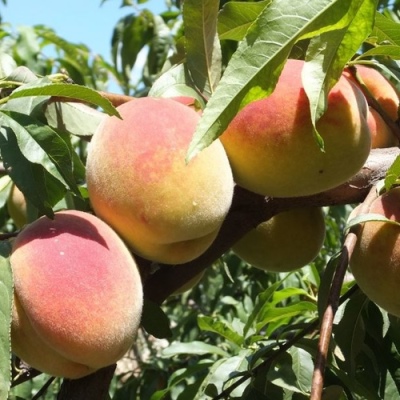
- Authors: Dragavtseva I.A., Yakovuk V.A., Zhukov A.S.
- Growth type: medium-sized
- Appointment: for fresh consumption, for canning
- Transportability: good
- Early maturity: begins bearing fruit in the 3rd year after planting
- Growing regions: Black Sea zone, foothills of Krasnodar Territory, Prikubanskaya zone
- Separability of the bone from the pulp: separates well
- Fruit composition: sugars - 6.73%, acids - 1.18%, P-active substances - more than 80.0 mg / 100g
- Winter hardiness: increased
- Fruit weight, g: 100-130
Laika is a peach variety bred by Russian breeders. And even if it is not so popular in gardening circles, it still has a lot of fans due to its rich classic taste and high marketability.
Description of the variety
Laika is a medium-sized tree type, reaching a height of 1.5-2 m. The plant has a compact crown, the leaves develop in a lanceolate shape and have small teeth. The root system lies at the level of 20-50 cm from the soil surface, and the flowering of the tree resembles a sakura blossom - during this period, pink or red flowers bloom on the tree.
Fruit characteristics
Laika peaches are quite large, their weight is 100-130 g. The fruit has a bright red skin, and inside there is a fleshy, sugary yellow pulp. The variety has high indicators of marketability and transportability.
Taste qualities
Laika has a pleasant harmonious taste and a pronounced aroma. The stone separates well from the pulp. Fresh fruit flavor is rated at 4.8 points, in addition, these peaches are used to prepare dried fruits and juices with pulp.
Ripening and fruiting
The tree bears its first fruits in the third year after planting. Flowering is observed in spring, and the harvest can be harvested in the second decade of July.
Yield
On average, the presented variety, subject to all the rules of agricultural technology, is capable of bringing 10-12 tons of fruit per hectare.
Growing and care
You need to start taking care of the tree already at the planting stage. Planting can be scheduled for spring (March-May) or autumn (August-November). The timing is chosen in accordance with the climatic conditions of the region where the crop is grown.
Laika will feel more comfortable in the garden soil. Planting consists of the following stages.
- Dig up the selected area, dig a planting hole with a diameter and depth of 60 cm. Divide the excavated soil into two parts - the upper and lower layers.
- Mix the top of the soil with compost, superphosphate, and potassium sulfate. Put the resulting composition on the bottom.
- Soak the seedling (by the way, it is better to give preference to planting material 1-2 years old) in water for 2-3 days.
- Drive a stake into the middle of the hole and place a seedling near it. Spread out the roots carefully.
- Cover the free space with earth and water the plant.
Growing the Laika variety is not difficult, but some rules must be followed.
- In the summertime, loosen the ridge regularly and remove weeds.
- This tree loves moderate moisture, so keep the sweet spot when watering and moisturize the soil as needed.
- The plant needs fertilizers annually in the fall. The type of top dressing is selected depending on the type of soil. Foliar formulations can be used.
- In the spring, before flowering, the tree should be pruned. The formation of the crown is carried out after one year, a plant more than 4 years old does not need to be formed. The crown should be thinned as often as possible in order to reduce the number of generative buds, the development of which is often characteristic of this variety. Additional sanitary pruning is allowed in the fall.
- The Laika variety is characterized by increased winter hardiness, therefore, it does not need shelter for the winter.





Review overview
The main advantage of Laika peach, according to gardeners, is its rich taste, as well as the aesthetic appearance of the tree during flowering - during this period the peach can become the main decoration of the garden. The advantage of agricultural technology is the high frost resistance of the variety. In addition, this variety is also suitable for industrial purposes. Among the disadvantages is the fact that seedlings are difficult to get, which can explain the small popularity of the variety among amateur summer residents.































































